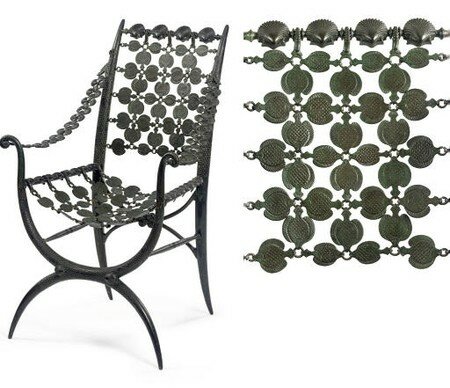Armand Albert Rateau - A patinated bronze armchair, circa 1919-20
Armand Albert Rateau - A patinated bronze armchair, circa 1919-20
Lot 417. Model no. 1793, from the Blumenthal commission - Estimate: $600,000-800,000
Note : This stunning armchair is one of eight recorded examples of the model. Six were originally created by Armand Albert Rateau for the wealthy American collectors Florence and George Blumenthal and it is from this group that the present armchair originated.
In 1919, Rateau and the Blumenthals happened upon each other while aboard the ocean liner La Savoie traveling between the U.S. and France and it was from this meeting that the Blumenthals became Rateau's first clients. The three had worked together previously, before the war while Rateau held the position of creative director in the prestigious French decoratiing firm Alavoine & Cie. However, in 1919, when they became re-acquainted, Rateau had set out to work independently.
Shortly after their transatlantic encounter the Blumenthals commissioned a suite of furniture for the patio surrounding the indoor pool at their sumptuous Manhattan townhouse. Taking his cue from the elaborate aquatic murals featuring mermaids swimming below the ocean amongst sea creatures and sea life, Rateau created his magical bronze suite (consisting of six armchairs, two tables and one lamp) with an intricate shell and marine life theme.
In 1941, upon George Blumenthal's death, Rateau's suite passed to a relative in Florida and made its way to the Palm Beach interior decoration and antiques company Smith Knudson Inc. In 1973, four of Blumenthal's six chairs were purchased by the jeweler George W. Headley III and placed in the fantastical mosaic, shell and stone encrusted Rococo grotto which he made from a three car garage on the grounds of his Lexington, Kentucky estate (today part of the Headley - Whitney Museum). The two remaining chairs from the Blumenthal commission were sold in New York at the DeLorenzo gallery, one to a private collector and, the present chair, in 1991, to Robin Roberts.
Two examples of this model are known to have been executed over and above the six for the Blumenthals. One belonged to Madame Rateau and featured within a display of her husband's works at the Metropolitan Museum of Art, New York in 1926. The exhibition showed contemporary French decorative arts that had been presented at the Exposition Internationale in Paris the previous year. At that time, George Blumenthal was a member of the Museum's advisory council before becoming its seventh president. In 1938, Madame Rateau gave her armchair to the Musée des Arts Décoratifs in Paris. When in 1964 the Museum organized an exhibition in celebration of the centenary of l'Union Centrale des Arts Décoratifs, this armchair was featured prominently.
The eighth example of the armchair is visible in period photographs of the bathroom of the Duchess of Alba in Madrid.
Occasionally Rateau would reproduce an object with slight modifications and also keep for himself examples of his most important creations. According to period photographs there were two variants to the 'Blumenthal' design. One includes an additional row of fish on the back rest, the other has a rectilinear cross stretcher on the back legs in contrast with the curved lines of the model created for the Blumenthals. However, no surviving examples of these variants are currently known.
Rateau's design no. 1793 - known as the Blumenthal armchair - is a 20th century icon. It is the perfect expression of Art Deco in its extreme refinement, elegance, invention and quality of execution. Rateau, like most of the great creators of this period, managed to express his individuality within the style, taking his inspiration from the close observation of nature and antiquity. Influenced by the decorative arts of the Hellenistic, Greco-Roman, Roman and Etruscan eras and by his travels to Naples and Pompeii in 1914, Rateau nonetheless brought a modern flavor to his designs. He successfully reinterpreted the traditional curule stool, moving the lyre shape from the side to the front of the seat and bringing an overall subtlety, elegance and fluidity to the form. His choice of bronze reflected the influence of the antique, and he endeavored to recreate the patinas that he observed on ancient works in bronze.
Close observation of the decorative details, the meticulous placement of the shell and fish motifs and their gracious integration with the structure reveals the work of a highly accomplished ornamentalist. The high quality of the casting and the faultless chasing further contribute to the refinement of his work. This perfectionism came to characterize everything that Rateau produced. Whilst this armchair is one of his earliest creations, it is nonetheless a masterful achievement and set the high standard for what was to follow.
At the time of the 1964 exhibition, curator Yvonne Bruhammer wrote: 'This armchair is a new instance of the influence of the antique on a man who exemplified qualities that are rarely found together - a creative imagination, a love of fine materials and an instinct for perfect execution. Rateau has created this armchair both as an aesthete and as a sculptor.'
All four armchairs from the Headley-Whitney Museum have been previously sold at Christie's in New York:
-Important 20th Century Decorative Arts, 10 December 1998, lots 190 and 191.
-Masterworks: 1900-2000, 8 June 2000, lot 225, later sold at Christie's, Paris, The Collection Claude et Simone Dray Art Deco, 8 June 2006, lot 52.
-Important 20th Century Decorative Arts, 15 June 2004, lot 92.
Christie's. Property from the Estate of Robin Roberts. 18 December 2007. 20 Rockefeller Plaza, New York

/https%3A%2F%2Fprofilepics.canalblog.com%2Fprofilepics%2F1%2F0%2F100183.jpg)
/https%3A%2F%2Fstorage.canalblog.com%2F03%2F02%2F119589%2F96711876_o.jpg)
/https%3A%2F%2Fstorage.canalblog.com%2F11%2F31%2F119589%2F94773502_o.jpg)
/https%3A%2F%2Fstorage.canalblog.com%2F20%2F83%2F119589%2F94772815_o.jpg)
/https%3A%2F%2Fstorage.canalblog.com%2F26%2F72%2F119589%2F75604929_o.jpg)
/https%3A%2F%2Fstorage.canalblog.com%2F59%2F60%2F119589%2F26458628_o.jpg)




/image%2F1371349%2F20240504%2Fob_93e6fc_440746014-1663431631093516-33520012940.jpg)
/image%2F1371349%2F20240504%2Fob_ad891b_441216662-1663349251101754-34964046851.jpg)
/image%2F1371349%2F20240504%2Fob_aed9af_441052920-1663343744435638-38708661590.jpg)
/image%2F1371349%2F20240504%2Fob_d96259_441052920-1663343744435638-38708661590.jpg)